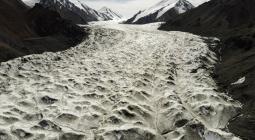Why are Himalayan glaciers melting faster than ever?

Numerous researchers and scientists say the Himalayan glaciers are shrinking far more rapidly than glaciers in other parts of the world – a rate of loss some describe as “exceptional”.
The Himalayas are home to the world’s third-largest amount of glacier ice after Antarctica and the Arctic, and are often referred to as the world’s “Third Pole”.
Why is the mountain range, which covers approximately 1,500 miles and passes through the nations of India, Pakistan, Afghanistan, China, Bhutan and Nepal, so badly affected?
-
How bad is the problem?
A study, led by the University of Leeds, concludes that over recent decades the Himalayan glaciers have lost ice ten times more quickly over the last few decades than on average since the last major glacier expansion 400-700 years ago, a period known as the Little Ice Age.
The paper, which is published in Scientific Reports, made a reconstruction of the size and ice surfaces of 14,798 Himalayan glaciers during the Little Ice Age. The researchers calculate that the glaciers have lost around 40 per cent of their area – shrinking from a peak of 28,000 km2 to around 19,600 km2 today.
During that period they have also lost between 390 km3 and 586 km3 of ice – the equivalent of all the ice contained today in the central European Alps, the Caucasus, and Scandinavia combined. The water released through that melting has raised sea levels across the world by between 0.92 mm and 1.38 mm, the team calculates.
Dr Jonathan Carrivick, one of the study authors and deputy head of the University of Leeds School of Geography, said: “Our findings clearly show that ice is now being lost from Himalayan glaciers at a rate that is at least 10 times higher than the average rate over past centuries.
“This acceleration in the rate of loss has only emerged within the last few decades, and coincides with human-induced climate change.”
-
Why is it getting worse?
Though the mountains are tens of millions of years old, their glaciers are extremely sensitive to the changing climate. Since the 1970s, when global warming first set in, the huge masses of ice have steadily thinned and retreated.
Man-made climate change is caused by the burning of fossil fuels such as gas, coal and oil, which release greenhouse gases such as carbon dioxide and methane into the atmosphere. This causes temperatures of the atmosphere and oceans to rise to levels that the vast majority of scientists say can’t be explained by natural causes.
Air pollutants from unclean energy sources also contribute to the problem. The dirty air deposits black carbon dust on the ice, which means the glaciers absorb more heat and thaw more rapidly.
"We must act urgently to reduce and mitigate the impact of human-made climate change on the glaciers," Carrivick said.
Study co-author Simon Cook of the University of Dundee said: “People in the region are already seeing changes that are beyond anything witnessed for centuries.
"This research is just the latest confirmation that those changes are accelerating and that they will have a significant impact on entire nations and regions.”
-
How does it effect the region?
The Leeds University-led study found accelerating melting of the Himalayan glaciers threatens the water supply of millions of people in Asia.
Meltwater released by Himalayan glaciers forms the headwaters of the major river systems in Asia. The acceleration of melting of Himalayan glaciers has significant implications for hundreds of millions of people who depend on Asia’s major river systems for food and energy. These rivers include the Brahmaputra, Ganges, and Indus.
The Himalayan region is home to over 50 million people, yet an estimated two billion people rely on waters from Himalayan glaciers for drinking, energy, agriculture and more.
Then there are natural disasters. In February 2021 a glacier burst and caused a flash flood in Joshimath, a city in the Indian state of Uttarakhand.
A portion of the Nanda Devi glacier had broken off, causing a deluge that hit the city’s Chamoli district.
More than 200 people, including dozens of workers who were trapped inside a tunnel in a dam, were killed in the disaster.
The ecology of Uttarakhand has been a serious concern for years. Many experts had pointed out that unplanned construction activities and mining in flood-prone areas and ecologically sensitive zones have exacerbated the risk of floods and other natural disasters in Uttarakhand.





